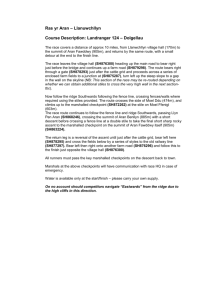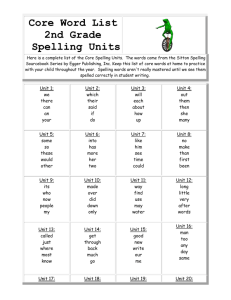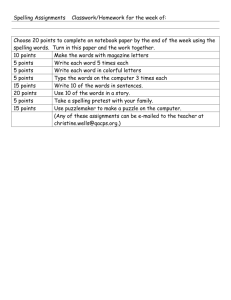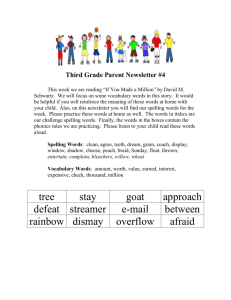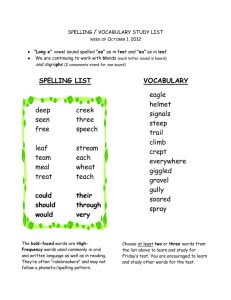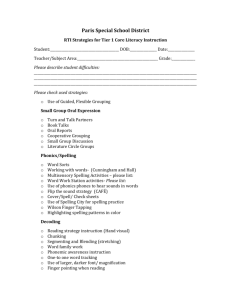Automatic Fingersign to Speech Translator
advertisement
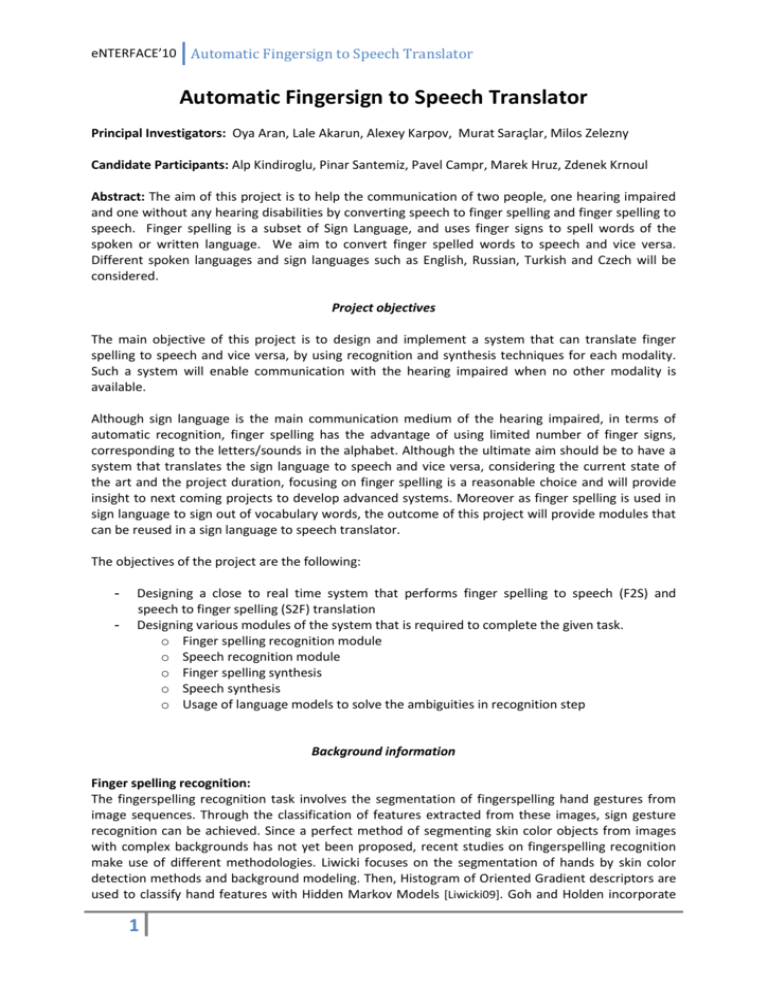
eNTERFACE’10 Automatic Fingersign to Speech Translator Automatic Fingersign to Speech Translator Principal Investigators: Oya Aran, Lale Akarun, Alexey Karpov, Murat Saraçlar, Milos Zelezny Candidate Participants: Alp Kindiroglu, Pinar Santemiz, Pavel Campr, Marek Hruz, Zdenek Krnoul Abstract: The aim of this project is to help the communication of two people, one hearing impaired and one without any hearing disabilities by converting speech to finger spelling and finger spelling to speech. Finger spelling is a subset of Sign Language, and uses finger signs to spell words of the spoken or written language. We aim to convert finger spelled words to speech and vice versa. Different spoken languages and sign languages such as English, Russian, Turkish and Czech will be considered. Project objectives The main objective of this project is to design and implement a system that can translate finger spelling to speech and vice versa, by using recognition and synthesis techniques for each modality. Such a system will enable communication with the hearing impaired when no other modality is available. Although sign language is the main communication medium of the hearing impaired, in terms of automatic recognition, finger spelling has the advantage of using limited number of finger signs, corresponding to the letters/sounds in the alphabet. Although the ultimate aim should be to have a system that translates the sign language to speech and vice versa, considering the current state of the art and the project duration, focusing on finger spelling is a reasonable choice and will provide insight to next coming projects to develop advanced systems. Moreover as finger spelling is used in sign language to sign out of vocabulary words, the outcome of this project will provide modules that can be reused in a sign language to speech translator. The objectives of the project are the following: - Designing a close to real time system that performs finger spelling to speech (F2S) and speech to finger spelling (S2F) translation Designing various modules of the system that is required to complete the given task. o Finger spelling recognition module o Speech recognition module o Finger spelling synthesis o Speech synthesis o Usage of language models to solve the ambiguities in recognition step Background information Finger spelling recognition: The fingerspelling recognition task involves the segmentation of fingerspelling hand gestures from image sequences. Through the classification of features extracted from these images, sign gesture recognition can be achieved. Since a perfect method of segmenting skin color objects from images with complex backgrounds has not yet been proposed, recent studies on fingerspelling recognition make use of different methodologies. Liwicki focuses on the segmentation of hands by skin color detection methods and background modeling. Then, Histogram of Oriented Gradient descriptors are used to classify hand features with Hidden Markov Models [Liwicki09]. Goh and Holden incorporate 1 eNTERFACE’10 Automatic Fingersign to Speech Translator motion descriptors into skin color based segmentation to improve the accuracy of hand segmentation [Goh06]. Gui makes use of human past behavioral patterns in parallel with skin color segmentation to achieve better hand segmentation [Gui08]. Finger spelling synthesis: The fingerspelling synthesis can be seen as a part of the sign language synthesis. Sign language synthesis can be used in two forms. The first is real-time generated avatar animation shown on computer screen that provides real-time feedback. The second form is pre-generated short movie clips inserted into graphical user interfaces. The avatar animation module can be divided to two models: 3D animation model and a trajectory generator. The animation model of the upper part of human body currently involves 38 joints and body segments. Each segment is represented as one textured triangular surface. In total, 16 segments are used for fingers and the palm, one for the arm and one for the forearm. The thorax and the stomach are represented together by one segment. The talking head is composed from seven segments. The relevant body segments are connected by the avatar skeleton. Rotations for shoulder, elbow, and wrist joints are commutated by inverse kinematics in accordance with 3D positions of wrist joint in the space. Avatar's face, lips and tongue are rendered by the talking head system morphing the relevant triangular surfaces. Speech recognition: Human’s speech refers to the processes associated with the production and perception of sounds used in spoken language, and automatic speech recognition (ASR) is a process of converting a speech signal to a sequence of words, by means of an algorithm implemented as a software or hardware module. Several kinds of speech are identified: spelled speech (with pauses between phonemes), isolated speech (with pauses between words), continuous speech (when a speaker does not make any pauses between words) and spontaneous natural speech. The most common classification of ASR by recognition vocabulary is following [Rabiner93]: small vocabulary (10-1000 words); medium vocabulary (up to 10 000 words); large vocabulary (up to 100 000 words); extra large vocabulary (up to and above million of words that is adequate for inflective or agglutinative languages) Recent automatic speech recognizers exploit mathematical techniques such as Hidden Markov Models (HMMs), Artificial Neural Networks (ANN), Bayesian Networks or Dynamic Time Warping (dynamic programming) methods. The most popular ASR models apply speaker-independent speech recognition though in some cases (for instance, personalized systems that have to recognize owner only) speaker-dependant systems are more adequate. In framework of the given project a multilingual ASR system will be constructed using the Hidden Markov Model Toolkit (HTK version 3.4) [Young06]. Language models based on statistical text analysis and/or finite-state grammars will be implemented for ASR [Rabiner08]. Speech synthesis: Speech synthesis is the artificial production of human speech. Speech synthesis (also called text-tospeech (TTS) system converts normal orphographic text into speech translating symbolic linguistic representations like phonetic transcriptions into speech. Synthesized speech can be created by concatenating pieces of recorded speech that are stored in a database (compilative speech synthesis or unit selection methods) [Dutoit09]. Systems differ in the size of the stored speech units; a system that stores allophones or diphones provides acceptable speech quality but the systems that are based on unit selection methods provide a higher level of speech intelligibility. Alternatively, a 2 eNTERFACE’10 Automatic Fingersign to Speech Translator synthesizer can incorporate a model of the vocal tract and other human voice characteristics to create voice output. The quality of a speech synthesizer is judged by its similarity to the human voice and by its ability to be understood (intelligibility). Properties of the considered languages (Czech, English, Russian, Turkish): Turkish is an agglutinative language with relatively free word order. Due to their rich morphology Czech, Russian and Turkish are challenging languages for ASR. Recently, large vocabulary continuous speech recognition (LVCSR) systems have become available for Turkish broadcast news transcription [Arısoy et al, 2009]. An HTK based version of this system is also available. LVCSR systems for agglutinative languages typically use sub-word units for language modeling. Detailed technical description a. Technical description The flowchart of the system is given in Figure 1. The project has the following work packages WP1. Design of the overall system In this work package the design of the overall system will be implemented. The system will be operating in close to realtime and will take the finger spelling input from the camera, or the speech input from the microphone and will convert it to synthesized speech or finger spelling. WP2. Finger spelling recognition Finger spelling recognition will be implemented for the finger spelling alphabets of considered languages. Language models will be used to solve ambiguities. WP3. Speech recognition Speech recognition will be implemented for the considered languages. Language models will be used to solve ambiguities. WP4. Finger spelling synthesis Finger spelling synthesis will be implemented WP5. Speech Synthesis Speech synthesis will be implemented WP6. System Integration and Module testing The modules implemented in WP2-WP5 will be tested and integrated in the system designed in WP1. 3 eNTERFACE’10 Automatic Fingersign to Speech Translator Language Model Figure 1. System flowchart b. Resources needed: facility, equipment, software, staff etc. - The training databases for the recognition tasks should be ready before the project. Additional data will be collected for adaptation and test purposes. Prototypes or frameworks for each module should be ready before the start of project. Since the project duration is short, this is necessary for successful completion of the project. A high fps, high resolution camera to capture finger spelling is required A dedicated computer for the demo application is required Staff with enough expertise is required to implement each of the tasks mentioned in the detailed technical description C/C++ programming will be used c. Project management One of the co-leaders for each week will be present during the workshop. Each participant will have a clear task that is parallel with their expertise Required camera hardware will be provided by the leaders. Work plan and implementation schedule A tentative timetable detailing the work to be done during the workshop; Week 1 WP1. Design of the overall system WP2. Finger spelling recognition WP3.Speech recognition WP4.Finger spelling synthesis WP5.Speech Synthesis WP6. System Integration and Module testing Final prototypes for F2S and S2F translators Documentation 4 Week 2 Week 3 Week 4 eNTERFACE’10 Automatic Fingersign to Speech Translator Benefits of the research The deliverables of the project will be the following: D1: Finger spelling recognition module D2: Finger spelling synthesis module D3: Speech Recognition module D4: Speech Synthesis module D5: F2S and S2F translators D6: Final Project Report Profile of team a. Leaders Short CV - Lale Akarun Lale Akarun is a professor of Computer Engineering in Bogazici University. Her research interests are face recognition and HCI. She has been a member of the FP6 projects Biosecure and SIMILAR, COST 2101: Biometrics for identity documents and smart cards, and FP7 FIRESENSE. She currectly has a joint project with Karlsruhe University on use of gestures in emergency management environments, and with University of Saint Petersburg on Info Kiosk for the Handicapped. She has actively participated in eNTERFACE workshops, leading projects in eNTERFACE06 and eNTERFACE07, and organizing eNTERFACE07. Selected Papers: Pinar Santemiz, Oya Aran, Murat Saraclar and Lale Akarun , Automatic Sign Segmentation from Continuous Signing via Multiple Sequence Alignment, Proc. IEEE Int. Workshop on Human-Computer Interaction, Oct. 4, 2009, Kyoto, Japan. Oya Aran, Lale Akarun, “A Multi-class Classification Strategy for Fisher Scores: Application to Signer Independent Sign Language Recognition, Pattern Recognition, accepted for publication. Cem Keskin, Lale Akarun, “ Input-output HMM based 3D hand gesture recognition and spotting for generic applications”, Pattern Recognition Letters, vol. 30, no. 12, pp. 1086-1095, September 2009. Oya Aran, M.S. Thomas Burger, Alice Caplier, Lale Akarun, “A Belief-Based Sequential Fusion Approach for Fusing Manual and Non-Manual Signs”, Pattern Recognition, vol.42 no.5, pp. 812-822, May 2009. Oya Aran, Ismail Ari, Alexandre Benoit, Pavel Campr, Ana Huerta Carrillo, Franois-Xavier Fanard, Lale Akarun, Alice Caplier, Michele Rombaut, and Bulent Sankur, “Signtutor: An Interactive System for Sign Language Tutoring". IEEE Multimedia, Volume: 16 Issue: 1 Pages: 81-93, Jan-March 2009. Oya Aran, Ismail Ari, Pavel Campr, Erinc Dikici, Marek Hruz, Siddika Parlak, Lale Akarun & Murat Saraclar, Speech and Sliding Text Aided Sign Retrieval from Hearing Impaired Sign News Videos , Journal on Multimodal User Interfaces, vol. 2, n. 1, Springer, 2008. Arman Savran, Nese Alyuz, Hamdi Dibeklioğlu, Oya Celiktutan, Berk Gokberk, Bulent Sankur, Lale Akarun: “Bosphorus Database for 3D Face Analysis”, The First COST 2101 Workshop on Biometrics and Identity Management (BIOID 2008), Roskilde, Denmark, 7-9 May 2008. Alice Caplier, Sébastien Stillittano, Oya Aran, Lale Akarun, Gérard Bailly, Denis Beautemps, Nouredine Aboutabit & Thomas Burger, Image and video for hearing impaired people, EURASIP Journal on Image and Video Processing, Special Issue on Image and Video Processing for Disability, 2007. Former eNTERFACE projects: Aran, O., Ari, I., Benoit, A., Carrillo, A.H., Fanard, F., Campr, P., Akarun, L., Caplier, A., Rombaut, M. & Sankur, B, “SignTutor: An Interactive Sign Language Tutoring Tool”, Proceedings of eNTERFACE 2006, The Summer Workshop on Multimodal Interfaces, Dubrovnik, Croatia, 2006. 5 eNTERFACE’10 Automatic Fingersign to Speech Translator Savvas Argyropoulos, Konstantinos Moustakas, Alexey A. Karpov, Oya Aran, Dimitrios Tzovaras, Thanos Tsakiris, Giovanna Varni, Byungjun Kwon, “A multimodal framework for the communication of the disabled”, Proceedings of eNTERFACE 2007, The Summer Workshop on Multimodal Interfaces, Istanbul, Turkey, 2007. Ferda Ofli, Cristian Canton-Ferrer, Yasemin Demir, Koray Balcı, Joelle Tilmanne, Elif Bozkurt, Idil Kızoglu, Yucel Yemez, Engin Erzin, A. Murat Tekalp, Lale Akarun, A. Tanju Erdem, “Audio-driven human body motion analysis and synthesis”, Proceedings of eNTERFACE 2007, The Summer Workshop on Multimodal Interfaces, Istanbul, Turkey, 2007. Arman Savran, Oya Celiktutan, Aydın Akyol, Jana Trojanova, Hamdi Dibeklioglu, Semih Esenlik, Nesli Bozkurt, Cem Demirkır, Erdem Akagunduz, Kerem Calıskan, Nese Alyuz, Bulent Sankur, Ilkay Ulusoy, Lale Akarun, Tevfik Metin Sezgin, “3D face recognition performance under adversarial conditions”, Proceedings of eNTERFACE 2007, The Summer Workshop on Multimodal Interfaces, Istanbul, Turkey, 2007. Short CV – Oya Aran Oya Aran is a research scientist at Idiap, Switzerland. Her research interests are sign language recognition, social computing and HCI. She is awarded with a FP7 Marie Curie International European Fellowship with NOVICOM (Automatic Analysis of Group Conversations via Visual Cues in Non-Verbal Communication) Project in 2009. She has been a member of the FP6 project SIMILAR. She currently has a joint project with University of Saint Petersburg on Information Kiosk for the Handicapped. She has actively participated in ENTERFACE workshops, leading projects in eNTERFACE06 and eNTERFACE07, eNTERFACE08 and organizing eNTERFACE07. Selected Papers: Oya Aran, Lale Akarun, “A Multi-class Classification Strategy for Fisher Scores: Application to Signer Independent Sign Language Recognition, Pattern Recognition, accepted for publication. Pinar Santemiz, Oya Aran, Murat Saraclar and Lale Akarun , Automatic Sign Segmentation from Continuous Signing via Multiple Sequence Alignment, Proc. IEEE Int. Workshop on Human-Computer Interaction, Oct. 4, 2009, Kyoto, Japan. Oya Aran, M.S. Thomas Burger, Alice Caplier, Lale Akarun, “A Belief-Based Sequential Fusion Approach for Fusing Manual and Non-Manual Signs”, Pattern Recognition, vol.42 no.5, pp. 812-822, May 2009. Oya Aran, Ismail Ari, Alexandre Benoit, Pavel Campr, Ana Huerta Carrillo, Franois-Xavier Fanard, Lale Akarun, Alice Caplier, Michele Rombaut, and Bulent Sankur, “Signtutor: An Interactive System for Sign Language Tutoring". IEEE Multimedia, Volume: 16 Issue: 1 Pages: 81-93, Jan-March 2009. Oya Aran, Ismail Ari, Pavel Campr, Erinc Dikici, Marek Hruz, Siddika Parlak, Lale Akarun & Murat Saraclar, Speech and Sliding Text Aided Sign Retrieval from Hearing Impaired Sign News Videos , Journal on Multimodal User Interfaces, vol. 2, n. 1, Springer, 2008. Alice Caplier, Sébastien Stillittano, Oya Aran, Lale Akarun, Gérard Bailly, Denis Beautemps, Nouredine Aboutabit & Thomas Burger, Image and video for hearing impaired people, EURASIP Journal on Image and Video Processing, Special Issue on Image and Video Processing for Disability, 2007. Former eNTERFACE projects: Pavel Campr, Marek Hruz, Alexey Karpov, Pinar Santemiz, Milos Zelezny, and Oya Aran, “Sign-languageenabled information kiosk,” in Proceedings of the 4th International Summer Workshop on Multimodal Interfaces (eNTERFACE’08), pp.24–33, Paris, France, 2008. Oya Aran, Ismail Ari, Pavel Campr, Erinc Dikici, Marek Hruz, Deniz Kahramaner, Siddika Parlak, Lale Akarun & Murat Saraclar, Speech and Sliding Text Aided Sign Retrieval from Hearing Impaired Sign News Videos , eNTERFACE'07 The Summer Workshop on Multimodal Interfaces, Istanbul, Turkey, 2007 Savvas Argyropoulos, Konstantinos Moustakas, Alexey A. Karpov, Oya Aran, Dimitrios Tzovaras, Thanos Tsakiris, Giovanna Varni, Byungjun Kwon, “A multimodal framework for the communication of the disabled”, Proceedings of eNTERFACE 2007, The Summer Workshop on Multimodal Interfaces, Istanbul, Turkey, 2007. Aran, O., Ari, I., Benoit, A., Carrillo, A.H., Fanard, F., Campr, P., Akarun, L., Caplier, A., Rombaut, M. & Sankur, B, “SignTutor: An Interactive Sign Language Tutoring Tool”, Proceedings of eNTERFACE 2006, The Summer Workshop on Multimodal Interfaces, Dubrovnik, Croatia, 2006. Short CV – Alexey Karpov 6 eNTERFACE’10 Automatic Fingersign to Speech Translator Alexey Karpov received his MSc from St. Petersburg State University of Airspace Instrumentation and PhD degree in computer science from St. Petersburg Institute for Informatics and Automation of the Russian Academy of Sciences (SPIIRAS), in 2002 and 2007, respectively. His main research interests are automatic Russian speech and speaker recognition, text-to-speech systems, multimodal interfaces based on speech and gestures, audio-visual speech processing, sign language synthesis. Currently he is a senior researcher of Speech and Multimodal Interfaces Laboratory of SPIIRAS. He has been the (co)author of more than 80 papers in refereed journals and International conferences, for instance, Interspeech, Eusipco, TSD, etc. His main research results are published by the Journal of Multimodal User Interfaces and by the Pattern Recognition and Image Analysis (Springer). He is a coauthor of the book “Speech and Multimodal Interfaces” (2006), and a chapter in the book “Multimodal User Interfaces: From Signals to Interaction” (2008, Springer). He leads several research projects funded by Russian scientific foundations. He is the winner of the 2-nd Low Cost Multimodal Interfaces Software (Loco Mummy) Contest. Dr. Karpov is a member of organizing committee of series of the International conferences “Speech and Computer” SPECOM, as well as member of the EURASIP and ISCA. He took part at eNTERFACE workshops in 2005, 2007 and 2008. Short CV – Murat Saraçlar Murat Saraçlar is an assistant professor at the Electrical and Electronic Engineering Department in Bogazici University. His research interests include speech recognition and HCI. He has been a member of the FP6 project SIMILAR and COST 2101: Biometrics for identity documents and smart cards. He currectly has a joint TUBITAK-RBFR project with SPIIRAS on Info Kiosk for the Handicapped. He has actively participated in eNTERFACE07. He is currently serving on the IEEE Signal Processing Society Speech and Language Technical Committee (2007-2009). He is an editorial board member of the Computer Speech and Language journal and an associate editor of IEEE Signal Processing Letters. Selected Papers: Pinar Santemiz, Oya Aran, Murat Saraclar and Lale Akarun , Automatic Sign Segmentation from Continuous Signing via Multiple Sequence Alignment, Proc. IEEE Int. Workshop on Human-Computer Interaction, Oct. 4, 2009, Kyoto, Japan. Ebru Arisoy, Dogan Can, Siddika Parlak, Hasim Sak and Murat Saraclar, “Turkish Broadcast News Transcription and Retrieval,” IEEE Transactions on Audio, Speech, and Language Processing, 17(5):874-883, July 2009. Ebru Arisoy and Murat Saraclar, “Lattice Extension and Vocabulary Adaptation for Turkish LVCSR,” IEEE Transactions on Audio, Speech, and Language Processing, 17(1):163-173, Jan 2009. Oya Aran, Ismail Ari, Lale Akarun, Erinc Dikici, Siddika Parlak, Murat Saraclar, Pavel Campr, Marek Hruz, “Speech and sliding text aided sign retrieval from hearing impaired sign news videos,” Journal on Multimodal User Interfaces, 2(2):117–131, Sep 2008. Former eNTERFACE projects: Oya Aran, Ismail Ari, Lale Akarun, Erinc Dikici, Siddika Parlak, Murat Saraclar, Pavel Campr, Marek Hruz, “Speech and sliding text aided sign retrieval from hearing impaired sign news videos”, Proceedings of eNTERFACE 2007, The Summer Workshop on Multimodal Interfaces, Istanbul, Turkey, 2007. Zeynep Inanoglu, Matthieu Jottrand, Maria Markaki, Kristina Stankovic, Aurelie Zara, Levent Arslan, Thierry Dutoit, igor Panzic, Murat Saraclar, Yannis Sylianou, “Multimodal speaker identitiy conversion”, Proceedings of eNTERFACE 2007, The Summer Workshop on Multimodal Interfaces, Istanbul, Turkey, 2007. Baris Bahar, Isil Burcu Barla, Ogem Boymul, Caglayan dicle, Berna Erol, Murat Saraclar, Tevfik Metin Sezgin, Milos Zelezny, “Mobile-phone based gesture recognition”, Proceedings of eNTERFACE 2007, The Summer Workshop on Multimodal Interfaces, Istanbul, Turkey, 2007. 7 eNTERFACE’10 Automatic Fingersign to Speech Translator Short CV – Milos Zelezny Milos Zelezny was born in Plzen, Czech Republic, in 1971. He received his Ing. (=M.S.) and Ph.D. degrees in Cybernetics from the University of West Bohemia, Plzen, Czech Republic (UWB) in 1994 and in 2002 respectively. He is currently a lecturer at the UWB. He has been delivering lectures on Digital Image Processing, Structural Pattern Recognition and Remote Sensing since 1996 at UWB. He is working in projects on multi-modal human-computer interfaces (audio-visual speech, gestures, emotions, sign language) and medical imaging. He is a member of ISCA, AVISA, and CPRS societies. He is a reviewer of the INTERSPEECH conference series. Selected Papers: Železný, Miloš; Krňoul, Zdeněk; Císař, Petr; Matoušek, Jindřich. Design, implementation and evaluation of the Czech realistic audio-visual speech synthesis. Signal Processing, 2006, roč. 86, č. 12, s. 3657-3673. ISSN: 0165-1684. Krňoul, Zdeněk; Železný, Miloš; . The UWB 3D Talking Head Text-Driven System Controlled by the SAT Method Used for the LIPS 2009 Challenge. In Proceedings of the 2009 conference on Auditory-visual speech processing. Norwich : School of Computing Sciences, 2009. s. 167-168. ISBN: 978-0-9563452-0-2. Krňoul, Zdeněk; Železný, Miloš. A Development of Czech Talking Head. Proceedings of Interspeech 2008 incorporating SST 2008, 2008, roč. 9, č. 1, s. 2326-2329. ISSN: 1990-9772. Campr, Pavel; Hrúz, Marek; Železný, Miloš. Design and Recording of Signed Czech Language Corpus for Automatic Sign Language Recognition. Interspeech 2007, 2007, roč. 2007, č. 1, s. 678-681. ISSN: 1990-9772. Hrúz, Marek; Campr, Pavel; Karpov, Alexey; Santemiz, Pinar; Aran, Oya; Železný, Miloš. Input and output modalities used in a sign-language-enabled information kiosk. In SPECOM'2009 Proceedings. Petrohrad : SPIIRAS, 2009. s. 113-116. ISBN: 978-5-8088-0442-5. Former eNTERFACE projects: Baris Bahar, Isil Burcu Barla, Ogem Boymul, Caglayan dicle, Berna Erol, Murat Saraclar, Tevfik Metin Sezgin, Milos Zelezny, “Mobile-phone based gesture recognition”, Proceedings of eNTERFACE 2007, The Summer Workshop on Multimodal Interfaces, Istanbul, Turkey, 2007. Pavel Campr, Marek Hruz, Alexey Karpov, Pinar Santemiz, Milos Zelezny, and Oya Aran, “Sign-languageenabled information kiosk,” in Proceedings of the 4th International Summer Workshop on Multimodal Interfaces (eNTERFACE’08), pp.24–33, Paris, France, 2008. b. Staff proposed by the leader The actual staff will be determined later however the following staff can be provided by the leaders: One MS student from Bogazici University, working on Fingerspelling recognition One MS/PhD student from Bogazici University working on speech recognition and synthesis One MS/PhD student from SPIIRAS working on speech recognition and synthesis Three MS/PhD students from University of West Bohemia working on sign synthesis and recognition c. Other researchers needed - MS or PhD student with good C/C++ programming knowledge. The student will work on the system design and multimodal system integration. References Ebru Arisoy, Dogan Can, Siddika Parlak, Hasim Sak and Murat Saraclar, “Turkish Broadcast News Transcription and Retrieval,” IEEE Transactions on Audio, Speech, and Language Processing, 17(5):874-883, July 2009 8 eNTERFACE’10 Automatic Fingersign to Speech Translator [Dutoit09] Dutoit T., Bozkurt B. Speech Synthesis, Chapter in Handbook of Signal Processing Acoustics, D. Havelock, S. Kuwano, M. Vorländer, eds. NY: Springer. Vol 1, pp. 557-585, 2009. [Goh06]P. Goh and E.-J. Holden, Dynamic fingerspelling recognition using geometric and motion features, in IEEE International Conference on Image Processing, pp. 2741 – 2744, Atlanta, GA USA, 2006. [Gui08]Gui, L . Thiran, J.P. and Paragios, N. Finger-spelling Recognition within a Collaborative Segmentation/Behavior Inference Framework. In Proceedings of the 16th European Signal Processing Conference (EUSIPCO-2008), Switzerland , 2008 [Liwicki09] Liwicki, S. and Everingham, M. (2009) Automatic recognition of fingerspelled words in British Sign Language. In: Proceedings of CVPR4HB'09. 2nd IEEE Workshop on CVPR for Human Communicative Behavior Analysis, Thursday June 25th, Miami, Florida. , pp. 50-57, 2009. [Rabiner93] Rabiner L., Juang. Fundamentals of Speech Recognition New Jersey: Prentice-Hall, Englewood Cliffs, 1993. [Rabiner08] Rabiner L., Juang B. Speech Recognition, Chapter in Springer Handbook of Speech Processing (Benesty, Jacob; Sondhi, M. M.; Huang, Yiteng, eds.), NY: Springer, 2008. [Young06] Young S. et al. The HTK book version 3.4 Manual. Cambridge University Engineering Department, Cambridge, UK, 2006 9
